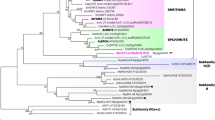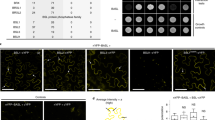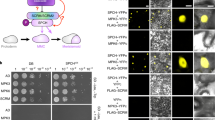Abstract
The establishment of new cell lineages during development often requires a symmetry-breaking event. An asymmetric division in the epidermis of plants initiates a lineage that ultimately produces stomatal guard cells. Stomata are pores in the epidermis that serve as the main conduits for gas exchange between plants and the atmosphere; they are critical for photosynthesis and exert a major influence on global carbon and water cycles1. Recent studies implicated intercellular signalling in preventing the inappropriate production of stomatal complexes2,3,4. Genes required to make stomata, however, remained elusive. Here we report the identification of a gene, SPEECHLESS (SPCH), encoding a basic helix–loop–helix (bHLH) transcription factor that is necessary and sufficient for the asymmetric divisions that establish the stomatal lineage in Arabidopsis thaliana. We demonstrate that SPCH and two paralogues are successively required for the initiation, proliferation and terminal differentiation of cells in the stomatal lineage. The stomatal bHLHs define a molecular pathway sufficient to create one of the key cell types in plants. Similar molecules and regulatory mechanisms are used during muscle and neural development5,6, highlighting a conserved use of closely related bHLHs for cell fate specification and differentiation.
This is a preview of subscription content, access via your institution
Access options
Subscribe to this journal
Receive 51 print issues and online access
$199.00 per year
only $3.90 per issue
Buy this article
- Purchase on Springer Link
- Instant access to full article PDF
Prices may be subject to local taxes which are calculated during checkout



Similar content being viewed by others
References
Hetherington, A. M. & Woodward, F. I. The role of stomata in sensing and driving environmental change. Nature 424, 901–908 (2003)
Shpak, E. D., McAbee, J. M., Pillitteri, L. J. & Torii, K. U. Stomatal patterning and differentiation by synergistic interactions of receptor kinases. Science 309, 290–293 (2005)
Bergmann, D. C., Lukowitz, W. & Somerville, C. R. Stomatal development and pattern controlled by a MAPKK kinase. Science 304, 1494–1497 (2004)
Nadeau, J. A. & Sack, F. D. Control of stomatal distribution on the Arabidopsis leaf surface. Science 296, 1697–1700 (2002)
Weintraub, H. et al. The myoD gene family: nodal point during specification of the muscle cell lineage. Science 251, 761–766 (1991)
Jan, Y. N. & Jan, L. Y. HLH proteins, fly neurogenesis, and vertebrate myogenesis. Cell 75, 827–830 (1993)
Nadeau, J. A. & Sack, F. D. Stomatal development in Arabidopsis. In The Arabidopsis Book. (eds Somerville, C. & Meyerowitz, E.) doi:10.1199/tab.0066 (American Society of Plant Biologists, 2002)
Lucas, J. R., Nadeau, J. A. & Sack, F. D. Microtubule arrays and Arabidopsis stomatal development. J. Exp. Bot. 57, 71–79 (2006)
Lai, L. B. et al. The Arabidopsis R2R3 MYB proteins FOUR LIPS and MYB88 restrict divisions late in the stomatal cell lineage. Plant Cell 17, 2754–2767 (2005)
Ohashi-Ito, K. & Bergmann, D. Arabidopsis FAMA controls the final proliferation/differentiation switch during stomatal development. Plant Cell 18, 2493–2505 (2006)
Geisler, M., Nadeau, J. & Sack, F. D. Oriented asymmetric divisions that generate the stomatal spacing pattern in Arabidopsis are disrupted by the too many mouths mutation. Plant Cell 12, 2075–2086 (2000)
Lukowitz, W., Roeder, A., Parmenter, D. & Somerville, C. A. MAPKK kinase gene regulates extra-embryonic cell fate in Arabidopsis. Cell 116, 109–119 (2004)
Geisler, M., Yang, M. & Sack, F. D. Divergent regulation of stomatal initiation and patterning in organ and suborgan regions of the Arabidopsis mutants too many mouths and four lips. Planta 205, 522–530 (1998)
Pillitteri, L. J., Sloan, B. D., Bogenschutz, N. L. & Torii, K. U. Termination of asymmetric cell division and differentiation of stomata. Nature doi: 10.1038/nature05467 (this issue).
Atchley, W. R. & Fitch, W. M. A natural classification of the basic helix-loop-helix class of transcription factors. Proc. Natl Acad. Sci. USA 94, 5172–5176 (1997)
Cutler, S. R., Ehrhardt, D. W., Griffitts, J. S. & Somerville, C. R. Random GFP:cDNA fusions enable visualization of subcellular structures in cells of Arabidopsis at a high frequency. Proc. Natl Acad. Sci. USA 97, 3718–3723 (2000)
Alonso, J. M. et al. Genome-wide insertional mutagenesis of Arabidopsis thaliana. Science 301, 653–657 (2003)
Yang, M. & Sack, F. D. The too many mouths and four lips mutations affect stomatal production in Arabidopsis. Plant Cell 7, 2227–2239 (1995)
Liu, C. M. & Meinke, D. W. The titan mutants of Arabidopsis are disrupted in mitosis and cell cycle control during seed development. Plant J. 16, 21–31 (1998)
Curtis, M. D. & Grossniklaus, U. A gateway cloning vector set for high-throughput functional analysis of genes in planta. Plant Physiol. 133, 462–469 (2003)
Kubo, M. et al. Transcription switches for protoxylem and metaxylem vessel formation. Genes Dev. 19, 1855–1860 (2005)
Acknowledgements
We thank members of the lab for discussion and comment on the manuscript and K. Torii for discussions and communication of data before publication. Some stocks were obtained from the Arabidopsis Biological Resource Center (ABRC) at Ohio State University. These studies were supported by a US National Science Foundation grant. C.A.M. was supported by an NIH Training grant to Stanford University.
Sequences have been deposited in Genbank under accession numbers: DQ868373 (SPCH messenger RNA); DQ863645 (MUTE mRNA) and DQ864972 (MUTE genomic).
Author information
Authors and Affiliations
Corresponding author
Ethics declarations
Competing interests
The authors declare no competing financial interests.
Supplementary information
Supplementary Information
This file contains Supplementary Methods; Supplementary Figures and Legends 1-5; Supplementary Notes (PDF 1314 kb)
Rights and permissions
About this article
Cite this article
MacAlister, C., Ohashi-Ito, K. & Bergmann, D. Transcription factor control of asymmetric cell divisions that establish the stomatal lineage. Nature 445, 537–540 (2007). https://doi.org/10.1038/nature05491
Received:
Accepted:
Published:
Issue Date:
DOI: https://doi.org/10.1038/nature05491
This article is cited by
-
Basic helix-loop-helix (bHLH) gene family in rye (Secale cereale L.): genome-wide identification, phylogeny, evolutionary expansion and expression analyses
BMC Genomics (2024)
-
Stomatal regulators are co-opted for seta development in the astomatous liverwort Marchantia polymorpha
Nature Plants (2023)
-
SIAMESE-RELATED1 imposes differentiation of stomatal lineage ground cells into pavement cells
Nature Plants (2023)
-
Integration of light and ABA signaling pathways to combat drought stress in plants
Plant Cell Reports (2023)
-
Spatially patterned hydrogen peroxide orchestrates stomatal development in Arabidopsis
Nature Communications (2022)
Comments
By submitting a comment you agree to abide by our Terms and Community Guidelines. If you find something abusive or that does not comply with our terms or guidelines please flag it as inappropriate.



